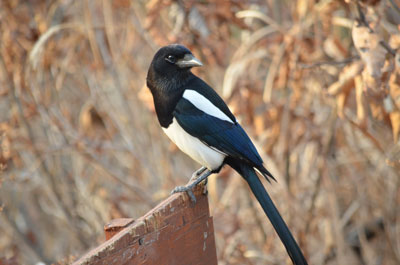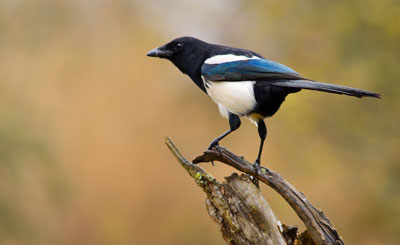




Black-billed magpies are in the family Covidae, which also includes ravens, crows, and jays. They are the birds that everyone loves to hate. It seems a contradiction that one of the most intelligent and beautiful of Montana birds has such a bad reputation. Magpies have a long history of conflict with humans and were extensively exterminated in the 1920s and 30s. However, magpie populations have increased, with problems occurring in localized areas where loose colonies have concentrated close to humans.
Since the most important items in their diet seem to be insects and small rodents, they are more beneficial than destructive to agriculture. Magpies have readily adapted to the presence of humans and have taken advantage of the new food sources.
Magpies are protected as migratory nongame birds under the Migratory Bird Treaty Act, which decreed that all migratory birds and their parts (including eggs, nests, and feathers) were fully protected. The Act is the domestic law that establishes and implements the United States commitment to four international conventions (with Canada, Japan, Mexico, and Russia) for the protection of a shared migratory bird resource.
Although protected, there are provisions to control "magpies, when found committing or about to commit depredations upon ornamental or shade trees, agricultural crops, livestock, or wildlife, or when concentrated in such numbers as to constitute a health hazard or other nuisance."
Magpies are very territorial and protective of their nests. During the nesting season, they will mob and attack humans, pets, and other birds near their nests. They will also bully other birds at feeders. Magpies tend to live in colonies. Large aggregations of these birds, usually in winter, can be very noisy and increase fecal droppings at roosts. The presence of magpies can increase local predation of beneficial wildlife. During nesting, magpies become aggressive and the mobbing of pets and people is common, but usually harmless for people. In addition, as magpie numbers increase, there is increased foraging in your gardens, fruit trees, and garbage. Magpies will easily tear open plastic trash bags to get at the garbage, spreading trash around and attracting other nuisances like dogs, raccoons, skunks, etc.
Magpies have large nesting structures, sometimes 48″ high by 40″ wide, which are built of sticks in low bushes or trees fairly low to the ground, rarely being over 25′ high. These large nests can be unsightly and damage plant structures.
Magpies are omnivorous and very opportunistic, which is characteristic of all the corvids. Most commonly, they feed on insects, fruit, baby birds, and roadkill. Preferring animal matter, they typically eat insects, but will take anything or what is most available. Animal matter is most important when rearing the young, and predation on other bird nests and poultry often increases during magpie breeding season.
